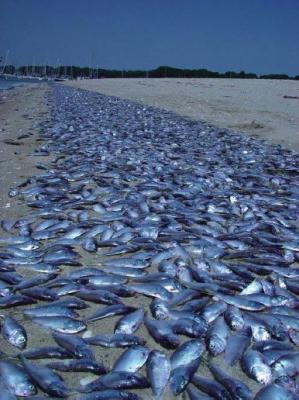Global warming doesn’t only hurt human beings. Ocean wind patterns are shifting due to changes in global climate.
A few months ago, the clear blue Pacific Ocean waters off the coast of Oregon suddenly turned a thick greenish brown. A swell of nutrients produced a bizarre blooming of plankton that reached levels never seen before by scientists. Then the plankton died and sank, causing oxygen levels in the water to plummet to zero.
The living ocean was transformed into a dead zone. Scientists conducted a submarine survey and found only the bodies of crabs and marine worms scattered across the ocean floor. There were no signs of any fish. Nothing had survived the cataclysm.(via)
It seems that the warming oceans are causing a shift in the wind patterns. This warming is caused by human beings and our co2 heavy lifestyle. Seasonal winds affect ocean currents by pushing away surface water, which is then replaced by colder water from below. But warmer land temperatures result in higher pressures and stronger winds, which in turn have an impact on currents. The patterns of these shifts are starting to wildly fluctuate as predicted in global warming climate models. This is the result of over 5 decades of data.
Last year’s ecosystem collapse on the Oregon coast was the second to strike there in as many years. In 2005, a nutrient-rich ocean current that normally appears off northern California and Oregon in spring was delayed by a month. This led to a loss of plankton, the microscopic plant organisms upon which larger animals depend for food. Salmon, which normally take to the sea at this time, starved. The effects rippled through the food web as predators, including sea birds, went hungry and died. Huge numbers of dead birds washed up on the shores.
‘Beaches were littered with the bodies of dead sea birds,’ said Dr Julia Parrish, from the University of Washington in Seattle. Many of the starving survivors have been unable to breed since then, she added.
Then, a year later, in 2006, the dead zone appeared and remained for nearly 17 weeks. ‘It grew to an area the size of the state of Ohio and lasted much longer than we thought would be possible, from something that we tracked day to day for months on end,’ said Dr Francis Chan, from Oregon State University in Corvallis. ‘It went from a low-oxygen system to a no-oxygen system. This had a dramatic effect on marine life.’

This is a fucked up lie.
Hi Boris
What part exactly do you feel is a lie? Because I assure you all of it is true.
Hi, did you take this horrific photograph? I am looking for an image such as this to pair with a story about dead zones. I work for the Marine Photobank, an ocean conservation image database (program of non-profit SeaWeb). Please let me know where the image comes from or if I can use it for non-commercial, conservation purposes. If you take pictures like this often you should look into becoming a contributor to our free resource. Check out http://www.marinephotobank.org. If you are interested in helping me out please email me at dharvey@seaweb.org. My name is Devin. Thanks